<p>Tucked away just south of the bustling metropolis of New Delhi, lies a remarkable treasure trove of history and antiquity – Mangar Bani, an ancient paleolithic archaeological site that has stirred the curiosity of researchers and history enthusiasts alike. Revered as one of the oldest and most extensive Neolithic archaeological sites in India, Mangar Bani unveils the secrets of human existence from times immemorial.</p>



<figure class="wp-block-image size-large"><img src="http://wildhawk.in/wp-content/uploads/2023/11/c1-1-1024x535.jpg" alt="" class="wp-image-6187"/><figcaption class="wp-element-caption">Images of Wall painting in the Lascaux Cave, Vezere Valley, France</figcaption></figure>



<h2 class="wp-block-heading">Unearthing Mangar Bani&#8217;s Remarkable Past</h2>



<p>Mangar Bani is more than just an archaeological site; it&#8217;s a sacred grove that resonates with historical significance. The site&#8217;s captivating rock paintings, among the oldest in the world, shed light on the artistic endeavors of our ancient ancestors.</p>



<h2 class="wp-block-heading">Key Insights into the Mangar Bani Paleolithic Site</h2>



<p>Situated on the outskirts of New Delhi, Mangar Bani stands as a rival to renowned paleolithic sites like Bhimbetka, boasting its own unique historical narrative:</p>



<ol class="wp-block-list">
<li><strong>Out of Africa Migration: Ancestral Origins</strong>
<ul class="wp-block-list">
<li>The site presents a compelling perspective on the out-of-Africa migration, suggesting that our modern human lineage may not directly trace back to the inhabitants who crafted stone tools here 100,000 years ago. Recent DNA evidence has illuminated this prehistoric odyssey, proposing that all non-Africans today share a common lineage that embarked on a journey out of Africa around 50,000 to 60,000 years ago.</li>
</ul>
</li>



<li><strong>A Multilayered Legacy:</strong>
<ul class="wp-block-list">
<li>The archaeological landscape of Mangar Bani is a layered tapestry of human history. The stone tool site dates back a staggering 100,000 years, showcasing the ingenuity of early inhabitants. In proximity, the cave paintings offer a window into the past, estimated to be between 20,000 and 40,000 years old. These temporal layers connect us with our ancestors in profound ways.</li>
</ul>
</li>
</ol>



<h2 class="wp-block-heading">Stepping into the Paleolithic World of Mangar Bani</h2>



<p>Around 100,000 years ago, our planet was a vastly different realm:</p>



<ol class="wp-block-list">
<li><strong>Coexisting Human Species: A Tapestry of Diversity</strong>
<ul class="wp-block-list">
<li>During this era, multiple human species shared the Earth, including Neanderthals, Denisovans, Homo floresiensis, and others. The world teemed with a rich mosaic of ancient cultures.</li>
</ul>
</li>



<li><strong>Pioneering Domestication: Dogs as Companions</strong>
<ul class="wp-block-list">
<li>Roughly 100,000 years ago, the journey of dog domestication may have begun. These loyal companions have since become integral parts of our lives.</li>
</ul>
</li>



<li><strong>A World of Extinct Giants</strong>
<ul class="wp-block-list">
<li>The Earth was inhabited by extraordinary creatures like mastodons, Columbian mammoths, dire wolves, North American camels, North American horses, giant ground sloths, and more, all of which have faded into extinction.</li>
</ul>
</li>
</ol>



<h2 class="wp-block-heading">Unraveling History&#8217;s Threads</h2>



<p>The <a href="http://wildhawk.in/mangar-village-where-nature-and-art-flourish/">Mangar Bani</a> stone tool site, dating to the Middle Paleolithic, belongs to the Old Stone Age, extending from approximately 300,000 to 30,000 years ago. The exquisite cave paintings mark the transition from the Middle Paleolithic to the Upper Paleolithic, a period of momentous change.</p>



<p>As Mangar Bani beckons explorers and history enthusiasts, it is a testament to human resilience and creativity throughout the ages. Each artifact and pigment-stained canvas preserves a unique chapter of our ancient past.</p>



<p>What Lies Beyond Mangar Bani: Venturing into the vicinity of Mangar Bani unveils further treasures to explore:</p>



<ol class="wp-block-list">
<li><strong>Asola Bhatti Wildlife Sanctuary: A Natural Haven</strong>
<ul class="wp-block-list">
<li>Adjacent to Mangar Bani, the Asola Bhatti Wildlife Sanctuary forms part of the Northern Aravalli leopard corridor, connecting to the famed Sariska Tiger Reserve. This sanctuary shelters a diverse array of wildlife, including leopards, hyenas, jungle cats, and porcupines.</li>
</ul>
</li>



<li><strong>Mangar Tribal Jewellery Museum: Glimpses of Tradition</strong>
<ul class="wp-block-list">
<li>At the Mangar Tribal Jewellery Museum, discover the intricate ornaments crafted by tribes from northeastern India. These pieces are fashioned from a medley of materials, including silver, gold plates, brass, bones, and glass.</li>
</ul>
</li>



<li><strong>Gudariya Das Baba Temple: A Sacred Grove&#8217;s Guardian</strong>
<ul class="wp-block-list">
<li>The ancient Gudariya Das Baba temple, enveloped by Mangar Bani&#8217;s sacred grove, is steeped in local legends. According to folklore, Saint Gudariya Das watches over the grove, safeguarding it from harm.</li>
</ul>
</li>
</ol>



<p>Mangar Bani&#8217;s enchanting history and the surrounding natural wonders invite all to embark on a journey through time and culture, providing a deep connection to the roots of human existence. It is a place where stories are etched in stone and paint, preserving a tapestry of human heritage for generations to come.</p>

